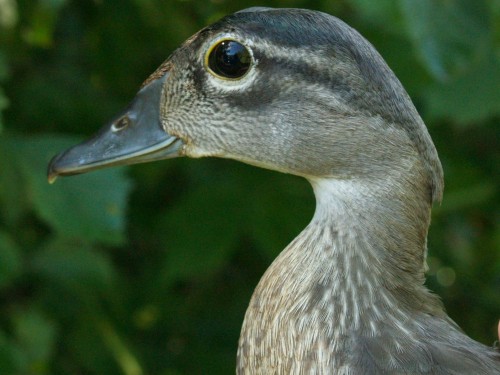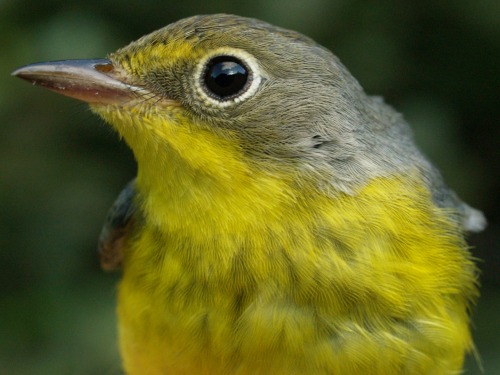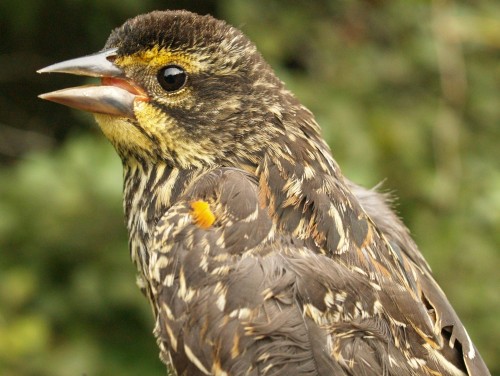|
Week 2: August 8-14, 2011 |
Welcome
to the McGill Bird Observatory weekly report.
Click here for a complete listing of our archives.
Comments or
questions are welcome at "mbo AT migrationresearch.org".
|
PICTURE
OF THE WEEK: |
|

Although Wood Ducks are a common sight at MBO from late March to early November,
we've never banded any until now. Four of them were hanging around the back ponds and
were remarkably tame - to the extent that three of them were easy to catch and
band.
They were not part of the standard fall banding program and therefore will not appear in
the season totals, but Wood Duck has become the 108th species banded at MBO.
(Photo by Simon Duval)
-
|
|
|
THIS WEEK |
THIS FALL |
2011 TOTAL |
SITE TOTAL |
|
# birds (and species) banded |
139 (34) |
396 (42) |
1484 (69) |
33053 (108) |
|
# birds (and species) repeat |
44 (17) |
94 (23) |
249 (34) |
5756 (68) |
|
# birds (and species) return |
1 (1) |
6 (2) |
101 (19) |
908 (37) |
|
# species observed |
75 |
82 |
140 |
202 |
|
# net hours |
560.0 |
1117.5 |
3954.5 |
53571.6 |
|
# birds banded / 100 net hours |
24.8 |
35.4 |
37.5 |
61.7 |
|
|
Note: table does not include nocturnal banding (owls) |
|
Bander-in-charge: Simon Duval, Gay Gruner
Assistants: Christine Barrie, Nicolas Bernier, David Davey, Rui de Jesus, Jean Demers, Nicki Fleming, Barbara Frei, Lima Kayello, Lisa Keelty, Chris Murphy, Clémence Soulard, Rodger Titman, Matthew von Bornhoft
Notes: Except in 2006, the number of birds banded in week 2 has always tended to drop off from week 1, and that pattern is especially stark this year, with this week's total of 139 banded representing only 54% of our count from last week. To some extent this probably reflects a fairly good count of locally-produced young that we band in the first week as a supplement to the migrants, but it also seems like there tends to be a slight lull between the first wave of really early migrants that push through in early August (or even late July) and the next group that begins to arrive later in August. The lower numbers this week certainly didn't reflect lack of effort, as we were able to get in our maximum of 560 net hours this week (16 nets open for 5 hours daily), but might have been influenced by the persistenly warm weather, with highs between 25 and 28 on six out of seven days, and nightly lows in the mid to high teens.

The migration of Canada Warblers is always one of the highlights of August at MBO. Of all species listed on the Species at Risk Act as Threatened or Endangered, this is the one we encounter most frequently. Last fall we banded a record 35 Canada Warblers, and we are hoping to record a good number again this year.
(Photo by
Simon Duval) |
While the number of birds banded this week was the lowest ever for week 2, the 75 species observed over the course of the week was slightly above the six-year average of 74. Among them were 14 new species for this fall: Canada Goose, Green Heron, Spotted Sandpiper, American Woodcock, Great Horned Owl, Least Flycatcher, Yellow-bellied Flycatcher, Purple Martin, Northern Rough-winged Swallow, Brown Creeper, Red-breasted Nuthatch, Black-throated Green Warbler, Canada Warbler, and Slate-colored Junco. Most of these species are right on schedule, although in many years Black-throated Green Warblers don't show up until the last week of August, and Brown Creepers are rare before mid-September. The biggest surprise though was the Slate-colored Junco, our first ever record for August; it's possible they nested this year in the adjacent Morgan Arboretum. Species banded for the first time this fall were Yellow-shafted Flicker, Least Flycatcher, Yellow-bellied Flycatcher, Brown Creeper, Canada Warbler, and Red-winged Blackbird. Also, as noted in the caption for the photo of the week, we banded Wood Ducks for the first time in MBO's history, taking advantage of the fact that a group of four had been hanging around for several days and were easily approachable. We have Wood Ducks breeding at MBO each year but have never had an opportunity to band them until now, so this will be an opportunity to see whether any of these individuals return next spring.
This week’s top 10 [last week's rank in brackets]
# individuals banded |
mean # individuals observed daily |
1. American Redstart (22) [3] |
1. Red-winged Blackbird (31) [1] |
2. Song Sparrow (16) [2] |
2. Cedar Waxwing (24) [2] |
3. Yellow Warbler (15) [1] |
3. Black-capped Chickadee (18) [4] |
4. Common Yellowthroat (10) [8] |
4. American Crow (17) [8] |
5. Cedar Waxwing (7) [4] |
5. American Robin (16) [5] |
6. Ovenbird (6) [-] |
6. Song Sparrow (13) [9] |
6. Tennessee Warbler (6) [8] |
7. American Goldfinch (12) [7] |
8. Traill's Flycatcher (5) [-] |
8. Yellow Warbler (10) [3] |
8. Baltimore Oriole (5) [8] |
9. Common Grackle (9) [6] |
10. Red-eyed Vireo (4) [-]
10. Black-capped Chickadee (4) [6]
10. Rose-breasted Grosbeak (4) [-] |
10. Common Yellowthroat (7) [-] |
|
The top three species banded remained the same as last week, except for Yellow Warbler and American Redstart swapping places. This is only the second time that American Redstart has taken top spot this early in fall (the other occasion being in 2008), and the 22 individuals banded is a record for week 2. With another 15 Yellow Warblers banded this week, the new season record is extended to 67 individuals, with the total surely to climb further before their migration tapers off near the end of August. The rest of the top ten shows less similarity to last week's results, with four new species added, and little carry-over from the strong first week showing of Nashville Warbler (only two were banded this week, compared to last week's 12). With five more Baltimore Orioles banded this week, the season total of 13 is already better than 2009 (12) and approaching last year's 15, but still far short of the record of 62 set in 2006.
Among species observed, the top nine species are the same as last week, with four of them (Red-winged Blackbird, Cedar Waxwing, American Robin, and American Goldfinch) even maintaining exactly the same rank this week. This marks the first time that Red-winged Blackbird has taken the top spot in week 2 of fall, and is actually the first time it has even been in the top ten for this week since 2007! Usually the local breeders disperse by late July, occasionally lingering into the first week of August, and then we see large flocks returning in the second half of fall, typically peaking in late October. For whatever reason (perhaps somewhat delayed nesting due to heavy rain early in summer?), the blackbirds have been hanging around longer this year; it will be interesting to see when they finally depart. Cedar Waxwings have also never before been so common at this time of year. On the other hand, Black-capped Chickadees were reliably consistent (over the past six years, the mean daily count for week 2 has ranged only from 15 to 18, resulting in a rank of third to eighth depending on the abundance of other species). American Crow and Song Sparrow both moved up in rank compared to week 1, while Yellow Warbler dropped off substantially, as also reflected in the far lower number banded. The only new addition to the list this week was Common Yellowthroat, replacing Red-eyed Vireo. Again we had some good swallow migration this week with 27 individuals of four species on August 11, and our only Purple Martin of the season to date among 30 swallows on August 12.
So far this fall we've had one week with a record high number of birds banded, and another with a record low ... what will week 3 bring us?
|

Red-winged Blackbirds are a rare catch at MBO over most of the fall season, with most of the birds banded in past years caught when stragglers from the late October flocks fly low enough through the woods adjacent to the back ponds and get caught in the B/N nets. This scruffy young male is only the third Red-winged Blackbird banded in August in 7 years.(Photo by
Simon Duval)
|



